Planning to visit Abbaye du Thoronet, one of the most iconic Cistercian abbeys in Provence? This Thoronet Abbey guide covers everything you need to know, from ticket prices, abbey opening times, and how to get there, to what makes its Romanesque architecture, 13-second acoustics, and silent cloister so unforgettable. Whether you’re traveling from Nice, staying nearby in Carcès or Le Thoronet village, or touring all three of the Cistercian Sisters (Thoronet, Sénanque, Silvacane), this post will help you plan your visit right and avoid the mistakes I made.
I visited Abbaye du Thoronet in mid-July with my husband and our toddler, on the way back from Carcès. We arrived in our camper van, parked in a shaded spot, and followed the self-guided flyer tour on foot. Our toddler rode in a baby carrier, which I recommend. The abbey is not stroller-friendly, but safe and manageable with little ones.
Visit Abbaye du Thoronet Guide
While the entire site was impressively clean and beautifully preserved, it was the Thoronet Abbey cloister and the Thoronet Abbey acoustics that stood out. Though you’re not technically allowed to sing inside, we caught another visitor breaking the rule, and we could hear the echo ripple through the stone for seconds. This historic monument is an architectural experience that engages all your senses.
But it’s not perfect. I had high expectations, and while the abbey is striking in its simplicity, it may feel underwhelming if you don’t appreciate what makes Cistercian austerity so powerful. That’s exactly why I wrote this: to share the kind of honest, personal, and detail-rich travel tips I couldn’t find before my visit.
This Abbaye de Thoronet guide includes everything I wish I’d known before visiting: how to plan the route, what to bring, which parts you might miss if you’re not paying attention, and how to make the most of it with kids in tow. It’s also a good introduction if you’re curious about Cistercian architecture but not sure why this abbey in Var Franceis such a big deal. I’ll explain how it was built, what each part meant to the monks who lived here, and why the silence still matters.
This is the most complete guide to visiting Abbaye du Thoronet available online, written by someone who actually went, made a few mistakes, and wants you to get it right.
Disclosure: Some of the links below are affiliate links. This means that at no extra cost to you, The Travel Bunny will earn a small commission if you click through and make a purchase. Thank you!

Abbaye du Thoronet History
Cistercian abbeys in Provence are more than architectural landmarks. They were designed to reflect a strict, silent, purpose-built world rooted in prayer, labour, and light. Abbaye du Thoronet is part of that legacy, built stone by stone by monks who valued order and austerity. If you understand how it started, what it went through, and how it survived, you’ll appreciate every corner of it more. This old church has been shaped by centuries of religious tension, abandonment, state intervention, and later, architectural admiration.
History of Cistercian Monks at Thoronet Abbey
The story begins in 1136, when a group of monks from Mazan Abbey left to establish a new community in the Var. They were part of the Cistercian movement, a reform of the Benedictines that began in 1098 at Cîteaux, led by monks who believed in returning to stricter monastic discipline.
The monks who settled in Thoronet didn’t start building right away. Construction began around 1160 and continued in phases until about 1230. What you see today is a near-perfect example of what they believed sacred space should look like: modest, controlled, intentional.
The abbey was never decorative. It was never meant to impress in a worldly sense. It was designed to regulate light, sound, and thought. Every curve, arch, and proportion reflects Cistercian values shaped by the Rule of Saint Benedict.
Thoronet Abbey Timeline: 1136 arrival, 1160 start of construction, 1230 completion. These weren’t wealthy monks building a showpiece. They were craftsmen building a tool for contemplation
The Role of the Conversi
In this abbey, like others in the order, not all men who lived and worked here were choir monks. The convers, or lay brothers, made up a large part of the community. These were men who lived under religious discipline but were not ordained. They came from rural backgrounds, worked the land, maintained the wine vats and the olive press, and followed a simplified version of the Rule.
They were critical to the abbey’s economy and survival. But they weren’t equals, they had no voice in the chapter. That meant no vote, no participation in decision-making. Their dormitories, workspaces, and church access points were separate.
Abbaye du Thoronet detail: The split between monks and lay brothers was literal and architectural. You’ll see it in the layout: double doors, different seating, and work zones placed well away from the choir.
Decline, Revolution, and Abandonment
The golden age of Thoronet didn’t last. Like most abbeys in France, it went into slow decline over the centuries. By the end of the 17th century, monastic life in this region had begun to unravel. By 1699, the decline of Thoronet Abbey was clearly visible. And by the time of the French Revolution, only seven monks remained.
In 1790, the Abbaye du Thoronet was closed and its religious community disbanded. Its land was sold, its objects scattered, and the buildings left to rot or be reused for secular purposes. This wasn’t unusual. Dozens of Provence monasteries and monasteries across France met the same fate, either repurposed or left in ruin.
What’s remarkable is how much of the structure survived. Unlike many churches that were looted or demolished, Thoronet Abbey remained mostly intact. But it stood empty, out of use, and largely forgotten.
Prosper Mérimée and the Abbey Restoration (1841-Today)
In 1841, a young inspector of historical monuments named Prosper Mérimée visited the abbey’s ruins. Already famous for his passion for French heritage (and later, for writing Carmen), he recognized Thoronet Abbey as something rare. He pushed for its protection, and his intervention marked the beginning of its slow rescue.
Abbaye du Thoronet was declared a Monument Historique in 1841. Thoronet Abbey restoration work began soon after, with several campaigns continuing through the 19th and 20th centuries. The French state eventually took full ownership and invested in preserving the site as a national treasure.
Thanks to Mérimée, Abbaye du Thoronet is one of the best-preserved Romanesque abbeys in France today. Every clean line you see now, every carefully rebuilt arch or cloister pillar, carries traces of that work. The abbey has been cleaned, repaired, and studied without being over-restored. It doesn’t feel new, it feels cared for.
UNESCO Significance and Cultural Protection
Thoronet is not a UNESCO World Heritage Site in name, but it meets every expectation of one in practice. As a patrimoine religieux de France, it benefits from state protection and is managed by the Centre des Monuments Nationaux.
Furthermore, it appears frequently in architectural studies and design programs as a reference point for sacred proportion and minimalism. Visitors come not only for religious reasons but to experience space, light, and structure in their purest form.
Abbaye du Thoronet is a national monument, a global reference for Cistercian design, and part of the spiritual and cultural fabric of Provence.
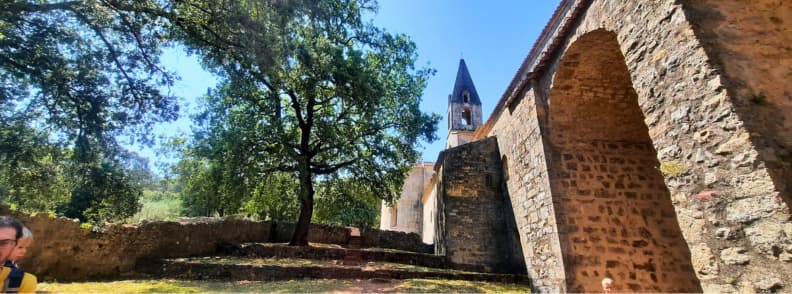
Thoronet Abbey Architecture & Significance
For anyone interested in Cistercian architecture, sacred geometry, and how proportion shapes the spiritual experience of a building, Abbaye du Thoronet is a living lesson. Its design follows rules laid down by the early Cistercian Order, refined over decades to create a space stripped of decoration but rich in meaning. Every curve and angle is deliberate. The walls are plain, the ornament minimal, and the proportions precise. Understanding the abbey’s structure makes walking through it far more rewarding.
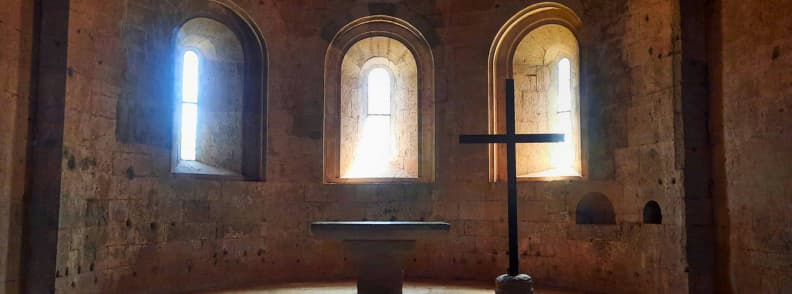
Cistercian Minimalist Principles
Abbaye du Thoronet embodies architecture cistercienne at its purest. The Rule of Saint Benedict encouraged restraint, and the Cistercians took that seriously. There is no coloured glass to distract the eye, and barely any statues to pull focus. The stone is bare, the arches clean, and the layout balanced. Every element serves a function first: to channel light where it’s needed, to focus attention on prayer, and to encourage silence.
The monks believed beauty came from proportion and order, not embellishment. That principle has kept Thoronet timeless. It still feels relevant because simplicity ages well.
Visit Abbaye du Thoronet Advice: Look at the way the arches meet the walls. Even without decoration, the geometry gives the building its rhythm
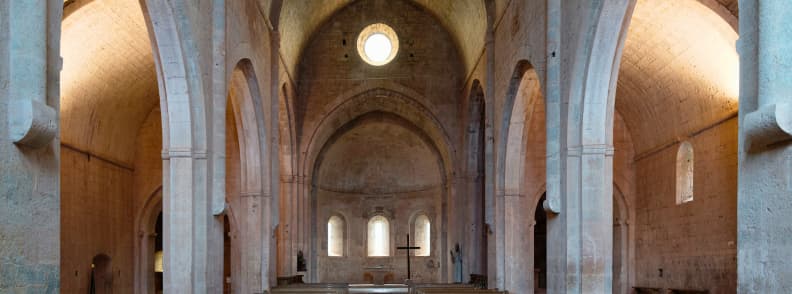
The Golden Ratio in the Abbey
Architects and historians have long noted that Thoronet Abbey’s layout follows the golden ratio, a mathematical proportion often linked to harmony and balance. From the length of the nave to the height of the vaults, the measurements line up with this ratio in ways that feel almost subconscious to the visitor. You may not see the numbers, but you feel the balance.
This use of sacred geometry was not decoration for its own sake. It was meant to reflect divine order, to create a physical space that mirrors spiritual ideals. The repetition of proportion between doorways, windows, and vaults creates a visual calm.
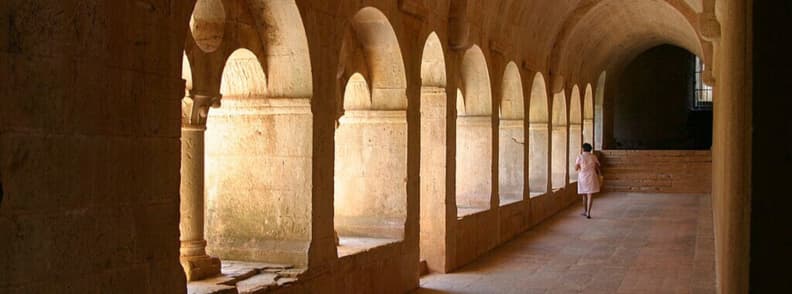
The Concept of Architecture of Truth
Thoronet Abbey is often called an architecture of silence or an architecture of truth. This is where my own expectations met reality. I had read so much about its power that I expected something grander. Instead, I found a stripped, almost austere interior that takes a moment to appreciate. The truth here is in the honesty of the materials and the lack of pretense.
The simplicity is deliberate. The sound of footsteps on stone, the way light falls in a narrow beam through a small window, these are the abbey’s ornaments. Once you adjust to this, you see how it works. But if you expect the drama of a Gothic cathedral, you might leave underwhelmed, as I did at first, until I understood that restraint is the point.
Influence on Le Corbusier
The 20th-century architect Le Corbusier visited Abbaye du Thoronet and was deeply influenced by its clarity and discipline. He saw in its design the same principles he wanted to apply to modern architecture: pure form, honest materials, and light as a key element of space.
Architectural historians often cite Thoronet Abbey as an example of how medieval religious buildings can inspire modernist design. Le Corbusier Foundation even references it as a touchstone for proportion and spatial logic.
Why did Le Corbusier visit Abbaye du Thoronet? To study how a building could be reduced to essentials without losing its soul. He found that here.
Romanesque and Early Gothic Elements
Thoronet Abbey sits at the meeting point of Romanesque architecture and the earliest touches of Gothic. The voûte en berceau (barrel vault) over the nave is pure Romanesque: solid, weighty, and rounded. The cul-de-four (half-dome) over the apse focuses attention on the altar. In the Thoronet Abbey chapter house, you see the croisée d’ogives (ribbed vaults), a structural innovation that would come to define Gothic design.
Comparison: Abbaye du Thoronet vs Sénanque vs Silvacane
Abbaye du Thoronet is one of the three sisters of Provence, alongside Sénanque and Silvacane. All are Cistercian, all were built within a few decades of each other, and all follow the same rules of proportion and simplicity. Sénanque is famous for its lavender fields, Silvacane for its riverside setting. Thoronet Abbey stands out for its acoustics and the integrity of its original plan.
I haven’t yet visited the other two, but they are on my list. When I do, I plan to trace the similarities and differences in person. For now, Thoronet feels like the most self-contained of the three, as if nothing unnecessary has ever been allowed inside.
What to Visit at Abbaye du Thoronet
Visiting Abbaye du Thoronet is best done in a slow loop, starting from the entrance and following the route suggested in the flyer you receive when you buy your ticket. Each space has a specific purpose, built to serve the strict routines of Cistercian life. The abbey is compact, but every part tells a story about how the monks lived, worked, and prayed. Understanding the nave, cloister, chapter house, and work areas will make your visit to Thoronet Abbey far richer. Here’s what to see at Thoronet Abbey:
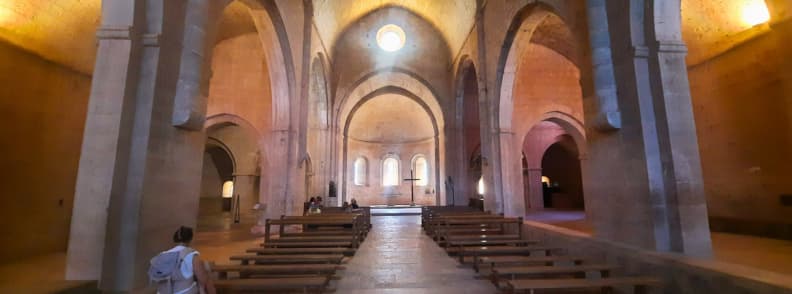
Abbaye du Thoronet Church (Nave, Choir, Apse, Enfeu)
The church is the heart of the abbey. The nave is long and narrow, its stone barrel vault drawing the eye forward to the choir and the cul-de-four (half-dome) of the apse. Light falls in controlled shafts, timed to the day’s prayers. On the side walls of the nave, I noticed faint wall paintings, a bit easy to miss unless you stop to look closely. They add a subtle layer of colour to an otherwise austere space.
There are two access points to the church: one from the dormitory and another from the cloister. We entered too early from the dormitory side, skipped part of the cloister, and had to double back. Following the flyer’s suggested order avoids this mistake.
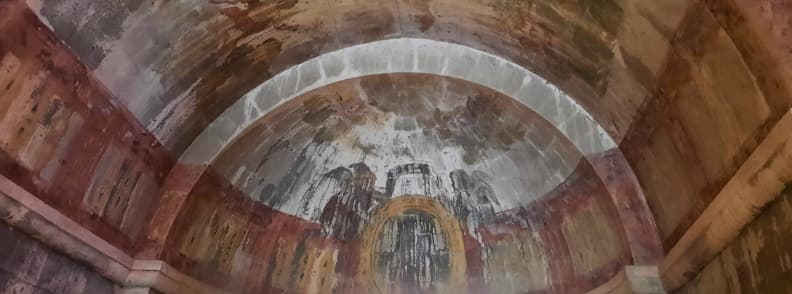
Visit Thoronet Abbey Advice: Take time in the nave, and look for the traces of painted decoration. They are rare in Cistercian churches.
Outside, along the south wall, you’ll find the enfeu, a recessed arched tomb space once used for the burial of important patrons or abbots. It’s easy to miss if you don’t walk the full exterior.

The Cloister (Arcades, Oculus)
The cloître médiéval is, for me, the most beautiful part of the Abbaye du Thoronet. Four covered walks enclose a small garden, their arcades géminées (paired arches) framing views of the inner square. The symmetry is calming, the air cooler than outside, and the sound of footsteps is softened by the stone.
An oculus in the Thoronet Abbey lavatorium area brings light into an otherwise shaded space, another example of the Cistercian eye for function and design. The cloister connects all major areas of the abbey and was the hub of monastic life.
If you only linger in one place, let it be here. The cloister captures the abbey’s quiet soul.
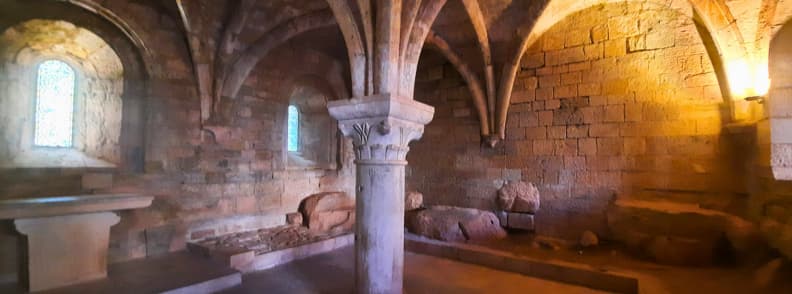
Thoronet Abbey Chapter House
The salle capitulaire is where the monks met each morning to read a chapter of the Rule of Saint Benedict and discuss the day’s business. Its croisée d’ogives (ribbed vaulting) marks it as one of the more architecturally ambitious rooms in the abbey. The proportions are exact, and the acoustics make even a soft voice carry clearly. You can stand in the centre and speak quietly to hear how the sound carries.

Thoronet Abbey Dormitory and Abbot’s Cell
The long monk dormitory is a simple hall with no partitions, just marked stone outlines showing where each bed once stood. This arrangement reflects the Cistercian ideal of equality among choir monks.
The cellule du Père Abbé, the private room for the abbot, is the exception. It’s modest but separate, symbolising his role as leader while still part of the community.
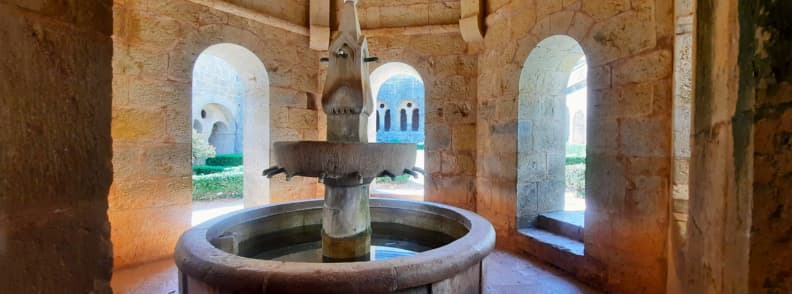
Refectory and Lavabo
The refectory was where all meals were taken in silence, accompanied only by the voice of a reader. The lavabo monastique outside the refectory provided a place for ritual hand washing before eating. Its placement along the cloister wall made it easy for the monks to wash and enter without breaking the order of movement.
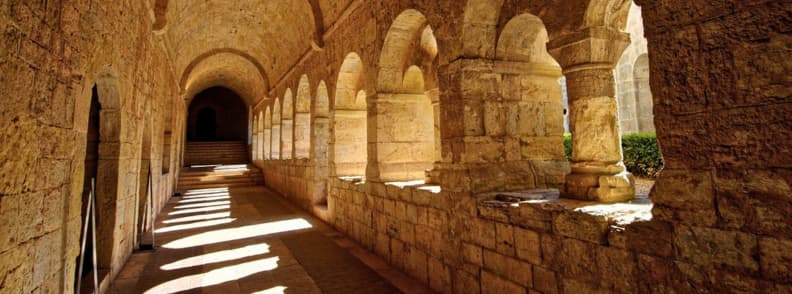
Armarium (Library)
The armarium was the abbey’s library. It’s a small niche rather than a grand hall. Here, religious texts and necessary documents were kept. In Cistercian life, books were shared and copied, and this modest space reflects their practical approach to learning.
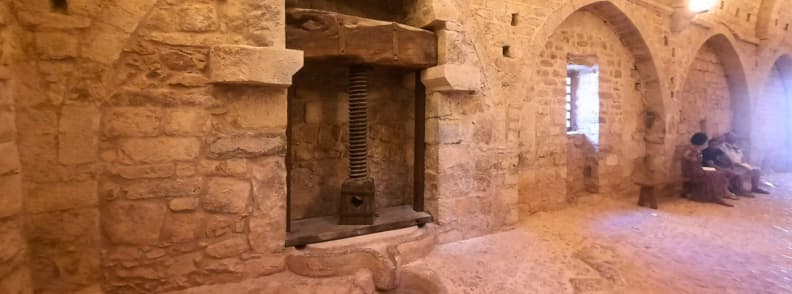
Thoronet Abbey Cellar, Olive Press, and Wine Vats
The Thoronet Abbey cellar showcases the monks’ economic self-sufficiency. The wine vats date from the 18th century, and a wooden screw press still stands where the monks once pressed olives for oil. This was one of the busiest work areas, managed mostly by the lay brothers.
Luckily, my husband is an engineer, so he explained to me (but also to other visitors) how the production process worked. Seeing the number of people trying to figure it out, it might be useful to have some more information available here.
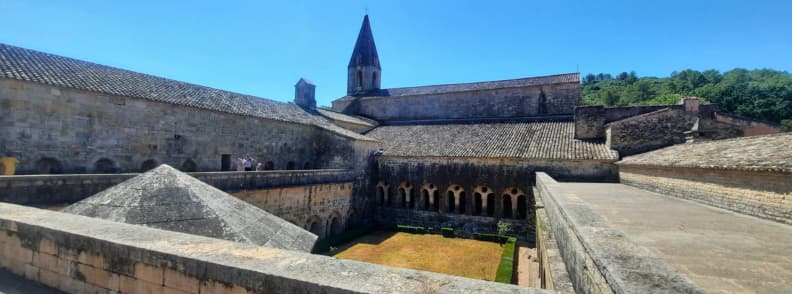
Parloir and Terrace
The parloir was the only space where monks could speak freely, usually to split their tasks. The cloister terrace offers a view out to the surrounding landscape, reminding you how isolated the abbey is from the outside world.
Grange Dîmière and Cemetery
The grange dîmière (tithe barn) was used to store the share of produce and goods owed to the abbey by tenants and surrounding farms.
The porte des morts leads to the small cemetery where monks were buried in unmarked graves, as was Cistercian custom. The Thoronet Abbey cemetery is simple, like the order’s ideals. The burial had no grand markers. It was a quiet return to the earth.
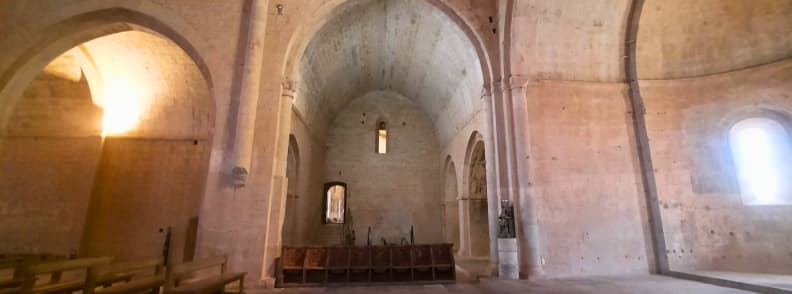
Acoustics and Sacred Music in Abbaye du Thoronet
Abbaye du Thoronet is as famous for its acoustics as it is for its architecture. Sound behaves here in a way that transforms even the simplest note into something almost otherworldly. The design of the church, with its stone vaulting, bare walls, and precise proportions, creates a resonance that musicians, architects, and acousticians have studied for decades. This is not an accident. The builders understood how space could shape sound, and they created one of the most remarkable acoustic environments in France.
Acoustic Properties of Thoronet Abbey
The church at Thoronet has a reverberation time of up to 13 seconds. That means a single note can linger in the air long after it has been sung. During my visit, although singing without permission is prohibited, a few visitors tried it. The moment they began, the sound spread through the nave, rose into the vaults, and returned in soft layers. It felt alive, as if the building itself had joined in.
Visit Abbaye du Thoronet Tip: If you want to hear this effect, stand in the centre of the nave and listen for the way the sound wraps around you.
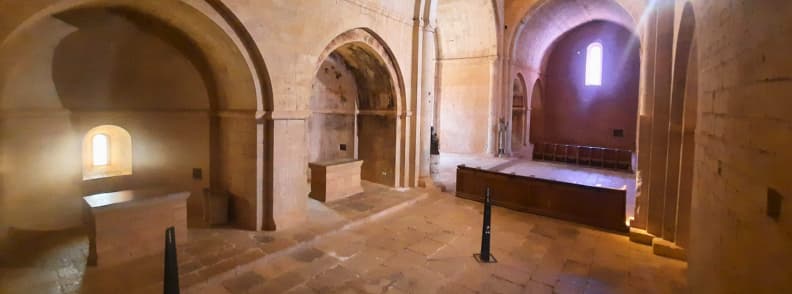
Acoustic Properties of Thoronet Abbey Church Explained
Architects and sound engineers have examined Abbaye du Thoronet church acoustics in detail. The long barrel vault of the nave, the smooth, undecorated stone, and the absence of absorbent materials all contribute to the extraordinary echo. Every surface reflects sound cleanly. The space was designed for plainchant, and it works so well that modern concert venues study its design for inspiration.
Gregorian Chant and Monastic Silence
The abbey was built for chant grégorien, where each phrase needs room to breathe before the next begins. The long reverberation would have forced the monks to sing slowly, letting the sound fade before continuing. Outside of services, silence ruled. The Cistercians practised near-total monastic silence, so the sound of chant or prayer was rare and deliberate, making it even more powerful when it happened.
Thoronet Abbey Events and Concerts
Today, Thoronet Abbey still hosts sacred music concerts, often as part of regional festivals. The programme concerts Thoronet usually includes Gregorian chant, early polyphony, and sometimes instrumental music that suits the space. Thoronet Abbey tickets for these events are sold separately from the standard entry and often sell out quickly.
I haven’t yet managed to attend a concert in Thoronet Abbey, but it’s at the top of my list for a future visit. Experiencing the acoustics with professional singers would be completely different from hearing a casual echo.
How to Experience the Sound in Thoronet Abbey
The best place to appreciate the acoustics is midway down the nave, standing on the central axis under the highest point of the barrel vault. Even without singing, a soft cough, a footstep, or the closing of a door will reveal the way sound lingers here. If you have the chance to join a guided visit that includes an acoustic demonstration, take it.
Abbaye du Thoronet Tip: Visit during a concert if possible, or at a quiet time when you can stand still and listen to the space breathe.
Artistic Value and Photography Tips Thoronet Abbey
For anyone passionate about photographing Thoronet Abbey, the site offers a combination of pure geometry, balanced light, and timeless textures. Its uncluttered design means that every line, shadow, and curve stands out, giving you endless possibilities for composition. Whether you’re working with a professional camera or a phone, the key is to understand how light moves through the space and how to frame the details without disrupting the abbey’s quiet atmosphere.
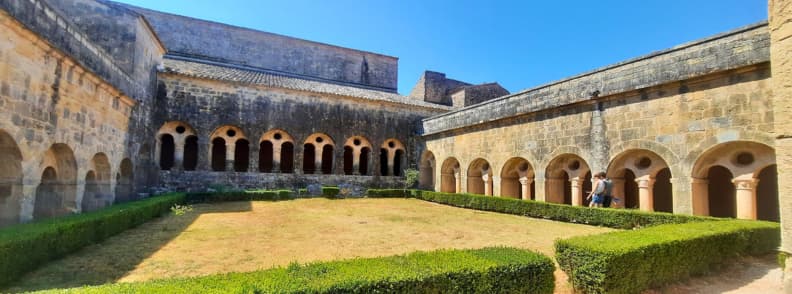
Thoronet Abbey Photography Tips and Best Viewpoints
Some of the best photography spots at Thoronet Abbey are found in the cloister, where the paired arches frame the inner courtyard like a sequence of ready-made images. Stand at one corner and shoot diagonally to capture both arcades and the light falling on the stone floor. Inside the church, a low angle from the nave looking towards the cul-de-four of the apse emphasises the height of the vault.
I took Thoronet Abbey photos freely during my visit, without flash, and there were no restrictions. The light is softer than in most churches because of the small, high-set windows, so expect gentle contrasts rather than harsh beams.
Abbey of Thoronet Photo Tip: If you want symmetry, centre yourself on the nave’s main axis and let the curve of the barrel vault guide the frame
Golden Hour Tips
Thoronet’s exterior stone takes on a warm, honeyed glow in the late afternoon, especially in summer. This is the ideal time for golden hour shots of the entrance façade and the cloister’s outer walls. In the morning, the light in the cloister garden is cooler and more even, which works well for detailed close-ups.
Interior Photography Rules
You can take photos inside, but always without flash. There are no ropes or barriers in most areas, so move carefully to avoid stepping into other visitors’ frames. Tripods are technically allowed only with prior permission, so if you need long exposures, bring a small, discreet travel tripod or use the floor for stability.
Equipment Suggestions
A wide-angle lens is useful for the nave and cloister, where you’ll want to capture the sweep of the arches. A standard zoom works for details like capitals, stone carvings, or the faint wall paintings in the nave. If you’re relying on a phone, switch to the ultra-wide setting for the cloister and use portrait mode for textures.
Abbaye du Thoronet Photo Tip: Shoot in RAW if possible to bring out the stone’s colour and texture in post-processing.
Thoronet Abbey in Art and Literature
Thoronet has inspired not only architects but also writers and artists. Fernand Pouillon’s novel Les pierres sauvages is a fictionalised account of the abbey’s construction, blending historical detail with imagined dialogue. The Portuguese architect Eduardo Souto de Moura has also cited Thoronet as an influence, drawn to its balance between proportion, light, and simplicity. Its reputation extends beyond tourism. The abbey is a study model for anyone interested in how design can shape emotion.
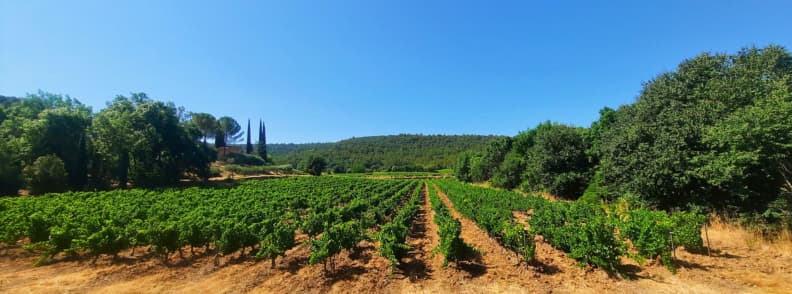
How to Get to Abbaye du Thoronet
Wondering what is the best way to reach Thoronet Abbey? Reaching Abbaye du Thoronet is straightforward by car, but less so by public transport. Thoronet Abbey in South of France sits in the countryside between Brignoles and Draguignan, surrounded by winding Provençal roads. Whether you’re coming from a nearby village or a major city, planning your route in advance will save you time and help you avoid problems parking at Abbaye du Thoronet, especially if you’re in a larger vehicle.
Driving Directions to Abbaye du Thoronet France
If you’re driving, the Thoronet Abbey is about 95 km from Nice, 80 km from Aix-en-Provence, and about 50 km from Toulon. From Brignoles, it’s around 20 minutes via the D13. The signage is clear once you’re in the Var, but some GPS systems suggest smaller, slower roads. Stick to the main departmental roads for the quickest and safest approach.
We drove from Carcès in a camper. The roads are fine for larger vehicles, but turning into the main car park is difficult with the length of our vehicle. If you’re in a camper or long-wheelbase van, using the Thoronet Abbey parking are for buses a might be your only choice.
How to Get to Thoronet Abbey by Bus
Reaching Thoronet Abbey without a car is possible but involves multiple connections. The nearest train stations are Les Arcs-Draguignan and Carnoules, both about 25-30 km away. From there, you’d need a regional bus to Le Thoronet village, then a taxi or a long walk to the abbey itself. There’s no direct bus stop at the entrance.
If you’re relying on public transport to Abbaye du Thoronet, check the Var Zou! network for seasonal schedules. Outside of summer, service can be limited.
Abbaye du Thoronet Parking Lot Information
The main car park is across the road from the Abbaye du Thoronet. Spaces are designed for cars, and there’s a separate bus area. With our camper, we could only park in the bus parking. Can’t complain, we got some shade, which is no small thing in the middle of July. It was empty when we arrived, and another camper followed our lead after trying the car park without success.
Abbaye du Thoronet Parking Tip: If your vehicle won’t fit in a standard space, use the bus area. Part of it is shaded and has easy turning space
Quick Thoronet Abbey Accessibility Guide
Thotonet Abbey grounds have partial disabled access. Thoronet Abbey gardens, entrance, cloister, and some ground-floor areas are wheelchair accessible, but the dormitory, chapter house, and other upper levels require stairs. The official website provides detailed information and suggests calling ahead if you have specific needs.
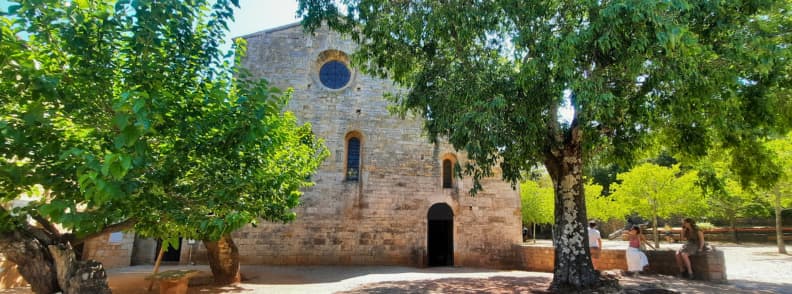
Abbaye du Thoronet Tour Options
Visiting Abbaye du Thoronet can be done entirely at your own pace or with the help of a guide. The experience you choose will shape how much you notice, as this is a place where meaning is often hidden in small details. Whether you want to follow a printed Abbaye du Thoronet map, hear historical context from a Thoronet Abbey guide, or organise a private visit for a group, there are several ways to experience the abbey.
Self-Guided Tour (Flyer and Map)
A self-guided visit is the most common choice. At the entrance, you’ll be given a Thoronet Abbey flyer with a detailed map and short descriptions of each area. It’s available in multiple languages and covers the main points of interest.
When I visited, no audio guide was offered at the desk, though we noticed other visitors using them later. The printed map and explanations worked well for us. I read them aloud to my husband while he was carrying our toddler in a baby carrier. If you prefer more in-depth commentary, ask about the audioguide Abbaye Thoronet when you arrive.
Visit Abbaye du Thoronet Tip: Follow the order on the flyer carefully. It prevents backtracking and helps you see the abbey in the intended sequence
Official Guided Tours to Thoronet Abbey
Thoronet Abbey also offers guided Thoronet Abbey tours in French at set times, especially during high season. These typically last around an hour and cover the history, architecture, and daily life of the monks. For visitors who understand French, a visite guidée Abbaye or visite commentée Abbaye du Thoronet adds depth that’s easy to miss on your own. Schedules can change seasonally, so it’s worth checking the official website or calling ahead if you want to book a tour.
Private and Group Tours to Annaye du Thoronet
For larger parties or thematic interests (such as architecture students, choirs, or historical study groups), the abbey can arrange private tours or tailored group visits. These often include behind-the-scenes access or focused talks on specific topics, from monastic wine production to medieval construction methods. Some regional tour companies also include Thoronet as part of a thematic tour of Provence abbeys, combining it with visits to Sénanque and Silvacane.
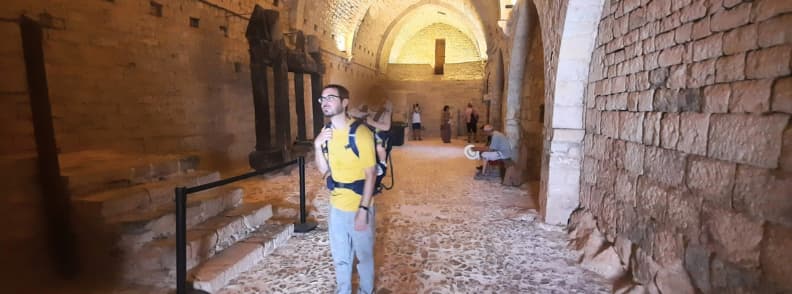
Plan Your Family Visit to Thoronet Abbey
Planning a family friendly visit to Thoronet Abbey with kids is easier than you might expect for a medieval heritage site. The compact layout, open outdoor spaces, and calm atmosphere make it a manageable stop on a family trip through Provence. While it’s not a playground, it’s safe enough for children to explore under supervision, and the visit is short enough to keep their attention.
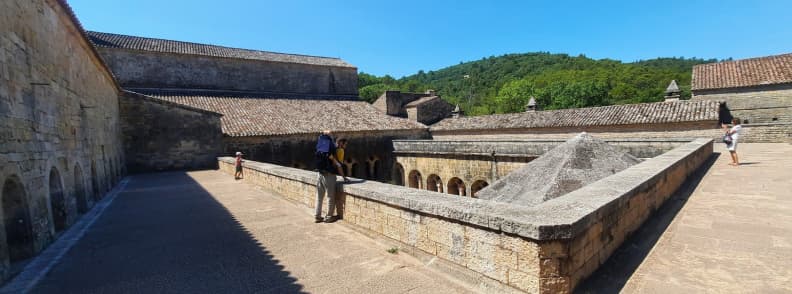
Visiting Abbaye du Thoronet with Children
When we visited, my husband carried our toddler in a baby carrier from start to finish. The visit took just over an hour, which worked well for his patience level. The cloister and the garden area gave him space to look around without feeling confined. If your children are used to cultural visits, visiting Thoronet Abbey with children is easy to include in your itinerary.
Family Travel Tip: The abbey is short enough to do with young children and safe if you supervise them.
Stroller-Friendly Areas
While there are a few flat sections where a stroller could fit, Thoronet Abbey’s stone steps, uneven floors, and narrow doorways make it better suited to carriers. They even advise the use of a baby carrier vs. that of a stroller. Pushing a stroller would be awkward and slow, especially inside the church and dormitory. Outdoors, the gravel paths are easier to navigate, but switching to a carrier will make the whole visit smoother.
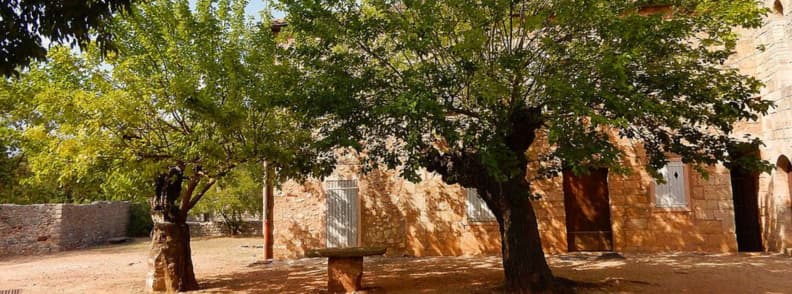
Child Safety Tips
Abbaye du Thoronet is generally a safe place with a toddler, as long as you keep an eye on them. The cloister garden and the open area outside the entrance are good for a short run-around if they get restless. There are no railings along some elevated walkways, so close supervision is important in those spots.
Family Travel Tip: Plan for active supervision inside, but enjoy the freedom to let them move more in the outdoor areas.
Educational Materials
Thoronet Abbey doesn’t have a dedicated children’s guide on-site, but the standard flyer can be adapted for kids by pointing out architectural features and explaining the monks’ daily routine in simple terms. For older children, you can link the visit to history lessons about medieval life, monastic orders, or even acoustics. Some schools in the region organise visite Abbaye en famille days, so check the Abbaye du Thoronet events calendar if you live locally.
Three Cistercian Sisters of Provence
In Provence, three Cistercian abbeys are often grouped together under the name trois sœurs de Provence or the three sisters Provence. All three Southern France abbeys were founded in the 12th century under the same architectural and spiritual principles, yet each developed its own character based on its setting and history. Visiting all three makes for an exceptional cultural itinerary, combining architecture, history, and the varied landscapes of southern France.
Visiting the Three Sisters of Provence Abbeys
The three Cistercian abbeys of Provence are Abbaye du Thoronet, Abbaye de Sénanque, and Abbaye de Silvacane. All three follow the Cistercian rules of architectural simplicity, proportion, and light control, yet each site reflects a different part of the Provençal landscape. Thoronet is in wooded hills, Sénanque in a lavender valley, and Silvacane near a river. Together, they form one of the most important sets of medieval monastic architecture in France.
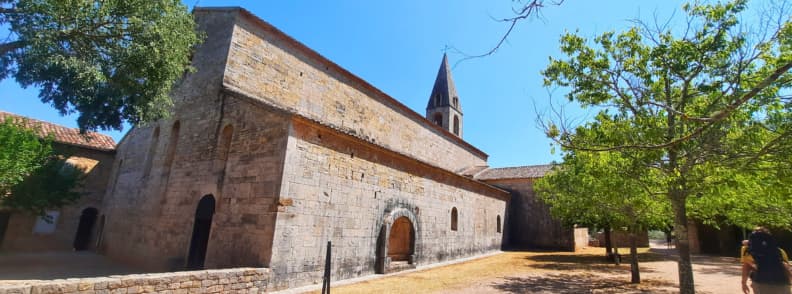
Thoronet Abbey Highlights
Thoronet is the most minimalist of the three, built entirely in stone with bare walls, strong geometric proportions, and an interior designed for perfect sacred acoustics. During my visit, what stood out was the balance between silence and sound, the long echo in the church, the cool quiet of the cloister, and the restrained beauty of the stonework. It’s the abbey that feels most untouched by time, as if the builders’ vision has been preserved without compromise.
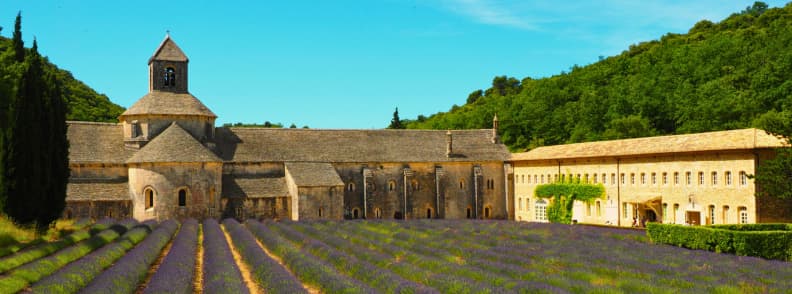
Sénanque Abbey
Abbaye de Sénanque, set in a valley surrounded by lavender fields, is the most photographed of the three. The image of purple rows leading up to its façade has made it an icon of Provence. It is still home to a small community of monks. I haven’t visited yet, but it’s on my list, especially in late June or early July when the lavender is in bloom. Next summer, I hope to combine Sénanque Abbey with a road trip in Provence to see lavender fields.
Silvacane Abbey
Abbaye de Silvacane stands on the banks of the Durance River, giving it a softer, more open feel than its sisters. It was abandoned earlier than Thoronet and Sénanque, but restoration has kept much of its medieval layout intact. Its riverside setting makes it unique, and it is often used today as a venue for cultural events and concerts.
Suggested Itineraries
If you want to see all three abbeys, you can do it in two or three days by car. A three abbey route might start at Thoronet, continue to Silvacane, and finish at Sénanque, following a loop through Provence’s backroads and villages. Another option is to combine one abbey with nearby attractions. For example, you can visit Thoronet with the wine villages of the Var, Sénanque with Gordes and the Luberon, and Silvacane with Aix-en-Provence or the Durance valley. This kind of Provence abbey itinerary is perfect for travellers who enjoy slower sightseeing with plenty of stops for photography, local food, and short walks.

Where to Stay and Eat Near Thoronet Abbey
The surroundings of Abbaye du Thoronet are rural and understated, which is exactly what makes them worth exploring. You won’t find chain hotels or tourist-saturated restaurants within walking distance. Instead, you’ll discover guesthouses tucked into vineyards, kitchens serving recipes passed down for generations, and quiet picnic corners shaded by olive trees. This is the part of a visit where knowing the local habits makes all the difference.
Accommodation Options Close to Thoronet Abbey
The closest Thoronet Abbey accommodation is in Le Thoronet village, about five minutes by car. One of the most appealing stays in Thoronet village is Villa Sisyphe Tiny House La Odette in Le Thoronet. This elegant holiday home has a beautiful garden, a terrace, and a seasonal outdoor swimming pool, perfect for cooling off after a summer visit. Inside, you’ll find a comfortable bedroom, bathroom, and fully fitted kitchen, along with air conditioning, a washing machine, and free WiFi. Guests have access to a bar, beauty services, and free private parking on-site. The property is well placed for exploring beyond Abbaye du Thoronet, with Le Pont des Fées, Château de Grimaud, and Port Grimaud all within easy driving distance.
In Carcès, about ten minutes away, a standout option is La Maison de Campagne, a bed and breakfast offering family rooms with private bathrooms and garden views from every window. Each room has its own entrance and cool tiled floors for the summer heat. Outside, guests can relax by the swimming pool with a view, enjoy the sun terrace, or make use of the picnic areas. A continental breakfast is served daily, featuring juice, fresh pastries, pancakes, cheese, and seasonal fruit. With free WiFi, a lounge, badminton equipment, and on-site parking, it’s a comfortable and welcoming base for exploring both the abbey and the surrounding villages.
If you prefer a livelier base with more dining options, Lorgues is about 15 minutes from the abbey and hosts one of the largest Provençal markets every Tuesday. Here, Hôtes’Antic Provence is an adults-only bed and breakfast set in a charming property with a sun terrace, garden, and seasonal outdoor swimming pool. Guests have access to a shared kitchen, electric vehicle charging, badminton equipment, and a coffee shop. The continental breakfast includes local specialties, fresh pastries, cheese, and fruits, and is highly rated for both quality and variety. Couples especially appreciate the peaceful setting and proximity to walking, hiking, and cycling routes.
Looking for a camping car park near Thoronet Abbey? In Carcès, you can stay in Camping Fouguières. If you prefer off-camping, arrive early to catch a spot in a parking by Caramy River or by Lac de Carcès.
Where to Eat Near Thoronet Abbey in Provençal Restaurants
Wonderfing where to eat lunch near Thoronet Abbey? Eating well here is part of the pleasure of visiting the abbey, and the right choice depends on whether you want a quick, satisfying stop or a long, lingering meal. Just outside Le Thoronet village, Restaurant Le Vallon is a local favourite that delivers generous wood-fired pizzas with thin, crisp bases and plenty of topping, alongside Provençal comfort dishes like daube de boeuf and roasted lamb with herbes de Provence.
The atmosphere is unfussy, with friendly service that makes it easy to relax whether you’re arriving in hiking gear or dressed for an evening out. It’s the kind of place where the owner might come over to ask how you liked the wine, and where regulars greet each other by first name.
A few minutes closer to the abbey, Les Restanques du Thoronet offers a very different experience. It’s refined yet still welcoming. Here, seasonal Mediterranean plates are served in a stone-walled dining room with views over the surrounding greenery. Expect dishes built around local produce: courgette flowers stuffed with fresh goat cheese, grilled fish drizzled with olive oil from nearby groves, and desserts like lavender crème brûlée that nod to the region’s flavours. The wine list favours Provençal vineyards, and the staff are happy to recommend pairings. Reservations are a good idea, especially in summer when visitors combine a tour of the abbey with a slow lunch here.
In Carcès, about ten minutes away, La Guinguette du Lac sits in a pretty lakeside setting that’s especially appealing in the late afternoon. The menu is casual but well executed (grilled meats, fresh salads with local cheese, and house-made fries), served on a terrace where you can watch the light shift over the water. Service is attentive without being rushed, and the setting makes it a pleasant spot to stretch out the day after exploring the abbey. If you arrive early, a short stroll along the lake before your meal gives you a different side of the Var countryside, away from the vineyards and stone villages.
Thoronet Abbey Picnic Spots
Locals often bring a basket from home and treat the Thoronet Abbey visit as a picnic outing. The designated picnic area is next to the Abbaye du Thoronet parking, equipped with wooden tables under tall trees. It’s ideal if you’re travelling with kids who need space to move before or after the visit.
For a quieter setting, take the small road behind the abbey towards the D84. Within five minutes, you’ll find pull-offs beside vineyards where you can lay a blanket and enjoy the view without another soul in sight. Early afternoon is best, as the light over the vines is warm but not harsh.
Abbaye du Thoronet Picnic Tip: Bring water, there is no public fountain in the area.
Domains and Wine Tasting Near Thoronet Abbey
Within a 15-minute radius, you have several domains producing AOC Côtes de Provence wines. Château Margillière, on the road to Brignoles, is known for organic rosés with a crisp mineral finish. Domaine de l’Estello, closer to Carcès, often welcomes drop-in visitors for tastings without requiring an appointment.
If you’re combining Thoronet Abbey with a wine visit, time it so you arrive at the vineyard around 16:00. This avoids the midday closure common in Provence and lets you finish with a golden-hour drive through the hills.
One underappreciated pairing is to visit the abbey in the morning, have lunch in Carcès, then spend the afternoon tasting wines in Cotignac, a cliffside village with a stunning troglodyte backdrop and several wine cellars within walking distance.
Things to Do Near Thoronet Abbey in Var
A visit to Abbaye du Thoronet can be the centrepiece of a day or a weekend in this part of the Var. The surrounding area is rich with small villages, Provence historical sites, and quiet stretches of countryside that feel far removed from the busier parts of Provence. From exploring the cobbled streets of Le Thoronet itself to walking local trails or discovering markets full of regional produce, there’s plenty to extend your stay.
Visit Thoronet Village
The village Le Thoronet sits just a short drive from the abbey and has the charm of a typical Var commune: narrow streets shaded by plane trees, stone houses with painted shutters, and a small square where locals gather at the café. It’s worth taking a slow walk through the centre to see the church, peek into artisan workshops, and browse the small grocery and bakery for picnic supplies. While many visitors pass straight to the Thoronet Abbey, the village rewards those who linger with an unhurried, authentic feel.
Château de Carcès
From my base in Carcès, about ten minutes from the abbey, the Château de Carcès was a visible reminder of the area’s layered history. Though not a furnished tourist castle, its towers and defensive walls make for a good short visit or a scenic photo stop when exploring the village. Carcès itself has a small but lively centre, with painted trompe-l’œil murals on buildings, a riverside walkway, and access to local restaurants and markets.
Hiking Trails Near Abbaye du Thoronet
Thoronet Abbey hikes can beautifully extend your visit. First, there’s a well-described local loop called the Boucle de l’Abbaye du Thoronet. It’s a 13.5 km walk starting right at the abbey, weaving through vineyards, forests, and charming hamlets. Expect about 4½ hours of walking over mixed terrain. It’s ideal if you’re up for a reflective stroll with scenic variety.
A shorter and easier option is the Abbaye du Thoronet – View of the Abbey loop, which spans roughly 4.4 km and takes around 1 hour 20 minutes. This moderate circuit offers viewpoints over the abbey and is accessible for most walkers.
If you’re exploring from Carcès, don’t miss the family-friendly hike to the Cascades de Caramy. It follows a shaded irrigation canal, making it an excellent option for toddlers in carriers and families wanting fresh air without steep climbs.
For history and craftsmanship lovers, the Monastère Notre‑Dame du Torrent de Vie lies just 500 meters from the abbey. You can reach it via a marked pilgrimage trail (GR 653A), which also connects to parts of the Saint‑Jacques‑de‑Compostelle route. It’s a serene detour, combining history with spiritual reflection.
Finally, the local commune hosts several protected natural and historical sites, including medieval structures like the Bourg Castral d’Envessènes, the Pont sur l’Argens, and the Lavoir des Fadons, all in the village landscape and rich in regional heritage.
Looking for more hiking trails around Thoronet Abbey? The Var department has a network of marked walking paths, so even unplanned detours can lead to rewarding viewpoints.

Local Markets Near Abbaye du Thoronet
If you’re visiting Abbaye du Thoronet, timing your trip around nearby markets adds vivid local color and plenty of fresh flavors to your itinerary. Here’s when and where to go if you want to shop side-by-side with Provençal residents, and not just visit the abbey.
In Le Thoronet itself, there’s a small but genuine market held every Tuesday morning from around 8:00 AM to 12:30 PM in the Place Louis Rainaud (or parking Rainaud). You’ll find local produce like fragrant early-season vegetables, olive growers, and maybe a few artisans showcasing pottery or woodwork.
Just a short drive from the abbey, Carcès hosts a lively market every Saturday morning, typically starting at 8:00 AM and wrapping up by 12:30 PM. Stalls include fruit and vegetable farmers, a fishmonger, charcutiers, flower vendors, and even a rattan weaver or local artisan.
If your visit falls in summer, consider timing your abbey visit early and then heading into Carcès for the weekly market afterward. You’ll have fresh picnic ingredients, local honey, and even regional crafts for sale, then settle under trees by the abbey with your basket.
If it’s a Tuesday, plan to stop in Le Thoronet’s market afterward. It’s intimate, local, and usually under the plane trees near the parking. Spring through early autumn, you’ll catch early apricots, herbs, early melons, and occasionally standalone woodworkers selling olive-wood utensils or painted ceramics.
For evening options, Carcès runs a night market (marché nocturne) every Thursday evening from around mid-July to late August in the village center. Expect local creatives, contemporary craft stalls, and often food trucks or casual street eats. It’s pleasant if you’re cooling off after a hot day.
Day Trips in the Var Region
From the abbey, you can easily reach other Var highlights in under an hour. Head to Cotignac for its dramatic troglodyte cliff dwellings and shaded main square. Visit Salernes, famous for its tiles and ceramics, where workshops are open to the public. Wine lovers can spend the day touring vineyards in the Côtes de Provence appellation, while nature enthusiasts can venture further to the Gorges du Verdon for hiking, kayaking, or simply admiring the turquoise river from a high viewpoint. These day trips in the Var make it easy to combine cultural visits with outdoor adventure.
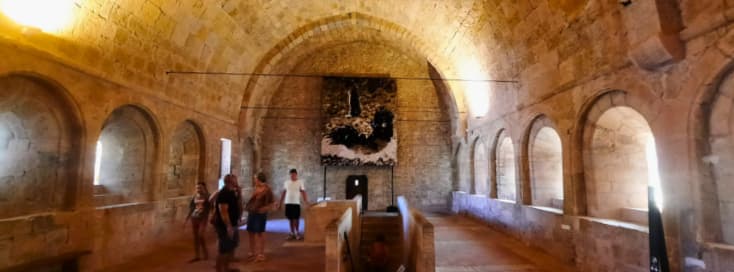
Abbaye du Thoronet Events, Retreats & Seasonal Tips
The experience of visiting Abbaye du Thoronet changes dramatically depending on the time of year and what’s on the calendar. From the deep resonance of sacred music concerts to special open days when admission is free, these events and seasonal considerations can turn a simple visit into something unforgettable.
Thoronet Abbey Concerts and Sacred Music France
Thoronet Abbey is best known for its sacred music concerts, which take full advantage of the church’s famous 13-second reverberation. The programme musique sacrée Thoronet runs mostly in summer, often as part of regional cultural festivals. Performances focus on Gregorian chant, medieval polyphony, and sacred instrumental works, sometimes by internationally known ensembles. Seats are limited, so checking the official website and booking well in advance is essential. I’m hoping to return specifically for one of these concerts. Hearing trained voices rise and dissolve in that acoustic would be completely different from the unplanned tourist singing I heard during my visit.
European Heritage Days
Every September, the abbey participates in the Journées du Patrimoine, when many French heritage sites open for free or host special Thoronet Abbey tours. At Thoronet Abbey, this often includes guided visits focusing on lesser-seen areas or conservation work, as well as short concerts or demonstrations of Cistercian building techniques. It’s a busy weekend, but a good opportunity if you want extra insight without extra cost.
Seasonal Tips from Spring to Winter
In spring, the surrounding landscape of Le Thoronet monastery is at its greenest, wildflowers dot the paths, and the temperature is mild. It’s perfect for combining the visit with a walk or picnic. Summer brings strong sun and heat, but I found mid-July surprisingly quiet, even on a national holiday, with the benefit of shaded parking and cool interiors. If you’re visiting in autumn, the vineyards nearby turn gold and rust, adding rich colour to photos. Winter is the quietest period; the abbey can feel almost monastic in its stillness, but be prepared for shorter opening hours and a chill inside the stone buildings.
Spiritual Retreats at Thoronet Abbey
While Thoronet Abbey is no longer a functioning monastery, it occasionally hosts spiritual retreats and workshops in partnership with religious and cultural organisations. These may include silent meditation days, chant workshops, or thematic stays combining guided visits with reflective time in the cloister. They are usually advertised on regional cultural calendars rather than the main tourist site, so checking local listings is key.
Les Leçons du Thoronet
The Les Leçons du Thoronet programme is a lesser-known but fascinating initiative that invites architects, students, and researchers to engage with the abbey’s design principles. Sessions often explore how contemporary architecture can be inspired by Cistercian proportions, light, and materials. While primarily aimed at professionals, some events are open to the public, offering a rare chance to hear experts discuss how a 12th-century building still shapes modern design thinking.
If you can time your visit with a concert or Les Leçons session, you’ll experience the Abbaye du Thoronet as a living space for culture and reflection.
Practical Tips for Your Visit to Thoronet Abbey
If you’re planning to visit Abbaye du Thoronet, get the basics right before you go. The abbey is easy to reach, calm even on busy weekends, and doesn’t take long to explore. But without some preparation, you might miss the things that make it memorable. I didn’t know exactly what to expect, and even with the flyer in hand, I ended up retracing steps and wishing I’d paid closer attention. This section covers the practical side of your visit, from correct opening hours, ticket prices, location coordinates, the best time to go, and what to bring or wear so you enjoy it fully without backtracking or overheating.
Where is Abbey du Thoronet?
Thoronet Abbey in South of France is located in Le Thoronet, Var, Provence-Alpes-Côte d’Azur, about 8 km from Carcès and 20 km from Brignoles. If you’re visiting Thoronet Abbey from Nice, it’s roughly 95 km and from Aix-en-Provence, about 80 km.
The GPS coordinates are 43.4789°N, 6.2431°E. You can enter “Abbaye du Thoronet” directly into Google Maps. The route is well signposted once you’re close.
We visited while staying in Carcès, driving in a camper van. Our vehicle didn’t fit in the car spaces, so we used the shaded bus parking area just to the right as you approach the entrance. Another camper tried the same thing after struggling with the main lot. If you’re in a larger vehicle, go straight there.
Abbaye du Thoronet Opening Hours & Ticket Prices 2026
Abbaye du Thoronet is open daily from 10:00 to 18:30 in the warm season (1 April to 30 September). Out of season, the Thoronet Abbey is open from 10:00 to 13:00 and from 14:00 to 17:00. Final entry is always 45 minutes before closing.
Tickets are sold on-site and online through the Monuments Nationaux website. The full price is €9, and the reduced rate is €7.50. Entry is free for EU residents under 26, children under 18, and on special dates such as the Journées Européennes du Patrimoine.
There’s no need to book in advance for regular visits. If you’re planning to attend a concert or special event, those tickets are separate and often limited, so check availability online beforehand.
Best Time to Visit Thoronet Abbey
I visited in mid-July, and despite the heat, the abbey felt cool and peaceful. The stone architecture holds the shade well. The cloister, especially, offered quiet shelter. Even on the French National Holiday, it never felt crowded.
Spring and autumn bring softer light and cooler air, which makes a difference if you’re hoping to appreciate the acoustics or take photos. In summer, arrive earlier or later in the day to avoid walking in full sun. In winter, it’s usually open but with shorter Thoronet Abbey hours and less natural light inside.
Visit Abbaye du Thoronet Advice: For the best light and experience, go in spring or early autumn, mid-morning or late afternoon.
How Long to Spend at the Abbey
We took just over one hour to explore everything slowly with a toddler in tow. That included reading the explanations, pointing things out, taking photos, and doubling back at one point after realizing we’d skipped part of the cloister. The site isn’t large, but the layout can be a bit confusing if you’re not careful.
If you’re alone or with adults only, forty-five minutes to one hour is enough for a relaxed visit. If you’re interested in Romanesque architecture or want to stay longer in the church to experience the acoustics, plan for ninety minutes.
How long does it take to visit Thoronet Abbey? Expect to spend 45-90 minutes depending on your pace and interest.
What to Bring and Wear
The abbey is not stroller-friendly. The floors are uneven, and steps appear frequently. We used a baby carrier, which worked well. I’d recommend the same for anyone visiting with young children.
Inside, temperatures stay cooler than outside, but in summer, you’ll still want water, a hat, and light breathable clothing. There’s no formal dress code, but you’re entering a sacred space. Most visitors wear everyday casual clothes, though I usually carry a light scarf in my bag out of respect.
Shoes matter. You’ll be walking on stone floors, often with a slight incline or curve. I wore sandals with good grip, and that was just enough.
Thoronet Abbey FAQs
Visitors to Abbaye du Thoronet usually arrive with a few practical questions in mind. Drawing on first-hand experience, here’s straightforward, reliable information so you can plan your visit with confidence and avoid surprises.
What to wear when visiting Thoronet Abbey? Is there a dress code to visit Abbaye du Thoronet?
There is no strict dress code enforced, but as with all churches in France, respectful clothing is expected. Covering shoulders and avoiding overly revealing outfits is advised, especially if visiting during religious or cultural events. Light, breathable fabrics work best in summer, while in winter, bring layers. The interior stays cool year-round.
Can you buy tickets online for Thoronet Abbey?
Yes, you can buy Thoronet Abbey tickets online through the Centre des Monuments Nationaux booking platform. This allows you to secure your entry for a specific date and skip potential queues at the entrance. Online purchase is especially useful in summer, on weekends, or during Journées du Patrimoine when visitor numbers increase.
Can you take photos at Thoronet Abbey?
Photography is allowed throughout the abbey, provided you do not use flash. I took photos freely during my visit, including in the nave and cloister, without issue. There are no rope barriers in most areas, but be mindful of other visitors and avoid blocking walkways, especially during guided tours. Tripods are only permitted with prior approval.
Are pets allowed on the grounds?
Pets are not permitted inside the abbey or cloister. Some visitors do bring dogs to the parking area and surrounding paths, but they must be kept on a lead. If you’re travelling with a pet, plan for someone in your group to stay with them outside while others visit.
Can I attend mass or service at Abbaye du Thoronet?
Thoronet Abbey no longer functions as a monastic community, so there is no regular mass schedule. However, occasional religious services may take place during special events, festivals, or retreats. If attending a service is important to you, check the Thoronet Abbey concert schedule and sacred music events or contact the site directly before your trip.
How to book tickets for Thoronet Abbey concerts?
Tickets for Thoronet Abbey concerts, particularly the sacred music performances, can usually be booked through the Centre des Monuments Nationaux website or via the abbey’s official events page. During summer, concerts often sell out quickly due to limited seating and the abbey’s exceptional acoustics. You can also purchase tickets in person at the abbey’s reception, but for high-demand events, booking online or by phone in advance is strongly recommended.
Can I book a private event or retreat at Thoronet Abbey?
Thoronet Abbey can be booked for certain private events such as concerts, professional photography sessions, and workshops, though strict preservation rules apply. You can occasionally book a spiritual retreat experience at Thoronet Abbey monastery through partner associations rather than directly by the abbey. For any booking inquiries, contact the management office well in advance, as availability is limited and subject to cultural programming.
Is Thoronet Abbey wheelchair accessible?
Thoronet Abbey offers partial wheelchair access. The main entrance, cloister, and certain ground-floor rooms are accessible, but upper floors such as the dormitory and chapter house require stairs. Some paths are paved, while others are compact gravel, and interior stone floors can be uneven. For specific mobility needs, it’s best to contact the abbey in advance to confirm accessible routes and available assistance.
Is there a gift shop at Thoronet Abbey?
Yes. Thoronet Abbey has a small gift shop near the ticket desk offering guidebooks in several languages, postcards, CDs of Gregorian chant recorded in the abbey, and regionally made products like olive oil, lavender sachets, and artisanal soaps. The selection is curated, focusing on quality and local connections rather than generic souvenirs.
What is the Cistercian order?
The Cistercian order is a Catholic monastic order founded in 1098 in Cîteaux, Burgundy, as a reform movement seeking a return to the strict observance of the Rule of Saint Benedict. Cistercians emphasised simplicity, manual labour, self-sufficiency, and prayer. Their architecture, as seen at Abbaye du Thoronet, reflects these principles with minimal ornamentation, perfect proportions, and an intentional play of light and shadow. The order spread across Europe in the 12th century, building monasteries in remote, rural locations to foster contemplation and work.
How to get to Thoronet Abbey from Nice?
From Nice, the fastest route by car is about 1 hour 30 minutes (approximately 95 km). Take the A8 motorway west toward Brignoles, exit onto the D13, and follow signs for Le Thoronet and the abbey. By public transport, you can take a train from Nice to Les Arcs–Draguignan or Carnoules, then a regional bus toward Le Thoronet village, followed by a taxi to the abbey. There is no direct public transport to the entrance, so if you’re not driving, factor in transfer time from the nearest bus stop or train station.

Why Abbaye du Thoronet Should Be on Your Provence Itinerary
Abbaye du Thoronet, a stop on the three Cistercian sisters route, is a place where stone, light, and silence have been in perfect balance for over 800 years. Whether you come for the Cistercian architecture, the legendary acoustics, or the quiet beauty of the Provençal countryside, the abbey leaves an impression that lingers long after you’ve stepped back into the sunlight.
Visiting here isn’t about ticking a monument off a list. It’s about slowing down enough to notice the curve of a barrel vault, the coolness of the cloister shade, or the way sound travels through an empty nave. From my own mid-July visit, I left with a sense that the abbey works best when you give it time.
Plan to explore beyond the walls, too. Pair your visit with Le Thoronet village, a walk in the surrounding Var trails, a stop at a local market, and perhaps a glass of Côtes de Provence rosé from a nearby vineyard. If you can, return for a sacred music concert and hear the space as it was meant to be experienced.
For travellers seeking authenticity, history, and moments of quiet beauty, Abbaye du Thoronet is an essential chapter in any Provence trip.
About the Author

I’m Mirela Letailleur, travel writer and founder of The Travel Bunny, where I share first-hand guides to cultural, food-focused, and slow-travel destinations across Europe. Living on France’s Côte d’Azur, I create detailed travel guides that blend personal experience with practical advice, so readers can explore with the same insider confidence I use when planning my own trips. My travels often take me to hidden villages, UNESCO sites, and local markets, and I’m just as happy hiking mountain trails as I am tasting my way through a region’s specialties.
I’ve won multiple blogging awards, sailed the Mediterranean with no prior experience, and lived in both Romania and France. I’m known for turning lived experiences into engaging narratives, from Provence road trips and French village life to La Réunion hiking adventures and family-friendly city breaks. Whether travelling with my husband, our young child, or solo, my goal is always the same: to give you reliable, experience-based travel advice that makes your journey richer, easier, and more memorable.
After planning a visit to Thoronet Abbey, check out these Var travel guides
Provence Weekend in Carcès: Village, Caramy Falls & Thoronet Abbey
Life in a French Village. The Realities of Moving to the South of France
Bagnols-en-Forêt: Discovering the Hidden Charm of Provence

